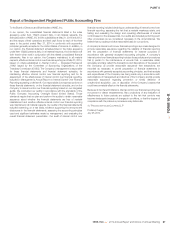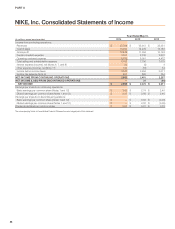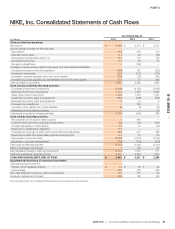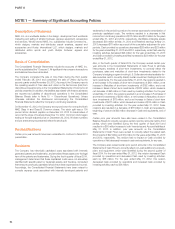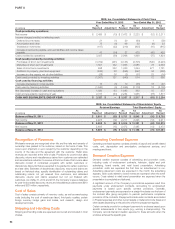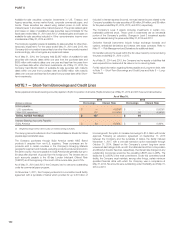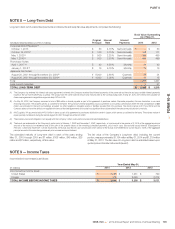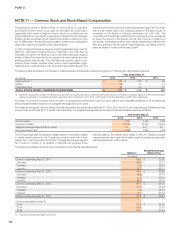Nike 2014 Annual Report Download - page 54
Download and view the complete annual report
Please find page 54 of the 2014 Nike annual report below. You can navigate through the pages in the report by either clicking on the pages listed below, or by using the keyword search tool below to find specific information within the annual report.
PART II
Certain contracts provide for variable payments based upon endorsers
maintaining a level of performance in their sport over an extended period of
time (e.g., maintaining a specified ranking in a sport for a year). These
amounts are recorded in Demand creation expense when the Company
determines that it is probable that the specified level of performance will be
maintained throughout the period. In these instances, to the extent that actual
payments to the endorser differ from the Company’s estimate due to
changes in the endorser’s performance, increased or decreased Demand
creation expense may be recorded in a future period.
Certain contracts provide for royalty payments to endorsers based upon a
predetermined percentage of sales of particular products. The Company
expenses these payments in Cost of sales as the related sales occur. In
certain contracts, the Company offers minimum guaranteed royalty
payments. For contracts for which the Company estimates it will not meet the
minimum guaranteed amount of royalty fees through sales of product, the
Company records the amount of the guaranteed payment in excess of that
earned through sales of product in Demand creation expense uniformly over
the remaining guarantee period.
Through cooperative advertising programs, the Company reimburses retail
customers for certain costs of advertising the Company’s products. The
Company records these costs in Demand creation expense at the point in
time when it is obligated to its customers for the costs, which is when the
related revenues are recognized. This obligation may arise prior to the related
advertisement being run.
Total advertising and promotion expenses were $3,031 million, $2,745
million, and $2,607 million for the years ended May 31, 2014, 2013 and 2012,
respectively. Prepaid advertising and promotion expenses totaled $516
million and $386 million at May 31, 2014 and 2013, respectively, and were
recorded in Prepaid expenses and other current assets and Deferred income
taxes and other assets depending on the period to which the prepayment
applies.
Cash and Equivalents
Cash and equivalents represent cash and short-term, highly liquid
investments, including commercial paper, U.S. Treasury, U.S. Agency, and
corporate debt securities with maturities of three months or less at date of
purchase.
Short-Term Investments
Short-term investments consist of highly liquid investments, including
commercial paper, U.S. Treasury, U.S. Agency, and corporate debt
securities, with maturities over three months from the date of purchase. Debt
securities that the Company has the ability and positive intent to hold to
maturity are carried at amortized cost. At May 31, 2014 and 2013, the
Company did not hold any short-term investments that were classified as
trading or held-to-maturity.
At May 31, 2014 and 2013, Short-term investments consisted of available-
for-sale securities. Available-for-sale securities are recorded at fair value with
unrealized gains and losses reported, net of tax, in Other comprehensive
income, unless unrealized losses are determined to be other than temporary.
Realized gains and losses on the sale of securities are determined by specific
identification. The Company considers all available-for-sale securities,
including those with maturity dates beyond 12 months, as available to
support current operational liquidity needs and therefore classifies all
securities with maturity dates beyond three months at the date of purchase as
current assets within Short-term investments on the Consolidated Balance
Sheets.
Refer to Note 6 — Fair Value Measurements for more information on the
Company’s short-term investments.
Allowance for Uncollectible Accounts
Receivable
Accounts receivable consists primarily of amounts receivable from
customers. The Company makes ongoing estimates relating to the
collectability of its accounts receivable and maintains an allowance for
estimated losses resulting from the inability of its customers to make required
payments. In determining the amount of the allowance, the Company
considers historical levels of credit losses and makes judgments about the
creditworthiness of significant customers based on ongoing credit
evaluations. Accounts receivable with anticipated collection dates greater
than 12 months from the balance sheet date and related allowances are
considered non-current and recorded in Deferred income taxes and other
assets. The allowance for uncollectible accounts receivable was $78 million
and $104 million at May 31, 2014 and 2013, respectively, of which $37 million
and $54 million, respectively, was classified as long-term and recorded in
Deferred income taxes and other assets.
Inventory Valuation
Inventories are stated at lower of cost or market and valued on either an
average or specific identification cost basis. For inventories in transit that
represent direct shipments to customers, the related inventory and cost of
sales is recognized on a specific identification basis. Inventory costs primarily
consist of product cost from the Company’s suppliers, as well as freight,
import duties, taxes, insurance and logistics and other handling fees.
Property, Plant and Equipment and
Depreciation
Property, plant and equipment are recorded at cost. Depreciation is
determined on a straight-line basis for buildings and leasehold improvements
over 2 to 40 years and for machinery and equipment over 2 to 15 years.
Depreciation and amortization of assets used in manufacturing, warehousing
and product distribution are recorded in Cost of sales. Depreciation and
amortization of other assets are recorded in Total selling and administrative
expense.
Software Development Costs
Internal Use Software. Expenditures for major software purchases and
software developed for internal use are capitalized and amortized over a 2 to
10 year period on a straight-line basis. The Company’s policy provides for the
capitalization of external direct costs of materials and services associated with
developing or obtaining internal use computer software. In addition, the
Company also capitalizes certain payroll and payroll-related costs for
employees who are directly associated with internal use computer software
projects. The amount of capitalizable payroll costs with respect to these
employees is limited to the time directly spent on such projects. Costs
associated with preliminary project stage activities, training, maintenance and
all other post-implementation stage activities are expensed as incurred.
Computer Software to be Sold, Leased or Otherwise Marketed. Development
costs of computer software to be sold, leased, or otherwise marketed as an
integral part of a product are subject to capitalization beginning when a
product’s technological feasibility has been established and ending when a
product is available for general release to customers. In most instances, the
Company’s products are released soon after technological feasibility has
been established. Therefore, software development costs incurred
subsequent to achievement of technological feasibility are usually not
significant, and generally most software development costs have been
expensed as incurred.
NIKE, INC. 2014 Annual Report and Notice of Annual Meeting 97
FORM 10-K


